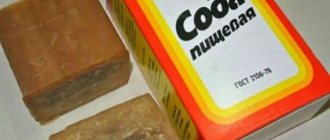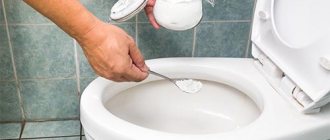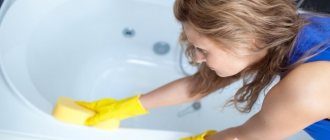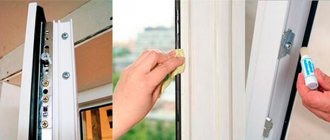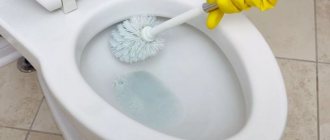Share on social media networks:
No matter how expensive and high-quality your plumbing is, nothing will make it shine clean forever without proper care. When it comes to toilets, the main problem they suffer from is urinary stone. The same yellowness that you can see under the rim and inside the toilet. And if the situation is further aggravated by the lack of regular cleaning and disinfection, the problem will soon appear in all its glory. You will learn how to clean the toilet lid from yellowness in this article.
Why does the toilet lid turn yellow?
Human urine has a special composition - certain minerals, which subsequently form urinary stones. If there is urine residue on the surface, plaque accumulates and builds up on the walls of the toilet. It just consists of urinary stone. This plaque builds up over time, and the longer it is not removed, the more difficult it will be to clean. However, there are certain tips on how to clean the toilet lid, and the toilet itself, from yellowness.
Important! Plaque usually covers not only the seat, but also the bowl itself, especially inside. There are several reasons for this, and each of them must be dealt with in its own way. Find out:
- How to clean a toilet from urinary stone?
- How to clean a toilet from limescale?
Traditional recipes for fighting old fat
Not all surfaces can be cleaned with aggressive chemicals or mechanical action (the most capricious are ceramic and Teflon). But there are also more gentle remedies that you can prepare yourself. In addition, the ingredients for most of them can be found at home, which means you can save money.
Laundry soap
One of the best and time-tested ways to wash a frying pan from grease from the inside has been inherited by modern housewives from Soviet times. To prepare such a home remedy, you will need 72 percent laundry soap and water.
To clean the inside of the frying pan, we proceed in stages:
- Grind half a bar of soap on a grater.
- Pour the shavings into a frying pan and fill with water.
- After the soap solution boils, turn the heat to low and leave for 25-30 minutes.
- Then turn off the heating, close the dish with a lid and let it cool.
- Drain the cold solution and wash the walls of the pan under hot water using a regular sponge.
How to clean a frying pan with laundry soap
The same laundry soap can also be used to remove multi-layer carbon deposits from the smoked sides of the outside of the dishes. To enhance the anti-fat effect, in addition to a bar of soap, you will also need a tube of silicate glue and soda ash. All ingredients dissolve in hot water. The main thing is to choose a container that will fit the entire frying pan or saucepan.
Preparing a solution of soap, soda and glue
After boiling, the solution with the dishes should be kept on low heat for 10-15 minutes. Then cover the pan with the soaking pan and let stand for 1-2 hours so that the carbon deposits soften thoroughly. After such a “bath”, it can be easily removed with the hard side of a washcloth or a dull knife.
Vinegar and citric acid
Using these products, you can not only clean a pot or frying pan from grease, but also remove yellowed deposits from plastic containers. You will need a liter of water and a small container. After boiling, add half a glass of table vinegar and a tablespoon of citric acid to the water. Soak the greasy dishes in a hot solution and leave for 45-60 minutes. After this, even old fat can be easily scraped off with a hard washcloth. Places where grease is strongly ingrained can be sprinkled with baking soda and vinegar. As a result of the reaction, foam is formed, which will help remove carbon deposits.
Vinegar effectively fights fat deposits
Note! This product cannot be used on aluminum cookware, and on Teflon and ceramic cookware - only for cleaning the outer walls (if they are uncoated)
Soda and salt
These products will surely be found in the kitchen of any housewife. With their help, you can not only prepare delicious dishes, but also clean your dishes efficiently. One of the most inexpensive ways to clean the outside of a pan from grease is to use salt and soda as an abrasive powder. They remove small dirt, thin grease and carbon deposits well; you just need to rub the damp walls with small granules, let them sit for a couple of minutes and rinse under warm water.
Salt and soda act as an abrasive powder
Salt or baking soda can also be used to clean the inside of dishes, but you need to be careful on coated pans. Simply sprinkle the powder onto the walls moistened with water and gently wipe with a soft sponge without pressing.
And after a couple of minutes, when the granules dissolve, wash in the usual way.
How to keep the toilet clean?
Having figured out where the yellow plaque on the toilet comes from, it’s time to find out how to deal with it. The easiest way to prevent the formation of urinary stones is regular cleaning, because it is always easier to carry out regular maintenance and keep the plumbing clean than to make efforts to remove old dirt.
You can keep your toilet clean and white in the following ways:
- regularly flush the water from the cistern after each visit to the toilet;
- daily remove splashes and drops from the toilet lid with toilet paper or a damp cloth;
- Once every few days, apply a toilet cleaner to the surface of the toilet to prevent the appearance of plaque;
- You can use special cassettes that are attached to the toilet, under the lid, and every time you press the flush button, a special product enters the toilet along with the water, which fights the formation of dirt and also has a pleasant aroma.
By following these simple rules, you are unlikely to encounter the problem of a strong yellow coating. And if you also read the article at the link with the rating of household chemicals, then you will no longer have any problems with further selection of the best toilet cleaning products.
Products from the kitchen
Every kitchen has universal means for washing dishes, removing clogs and dirt from all surfaces:
- vinegar;
- soda;
- lemon acid;
- white.
They are used to remove limescale from the toilet and clean it until it shines.
It is preferable to get 70% vinegar, vinegar essence. It is poured into the toilet, approximately 200 - 250 ml and 100 ml into the tank, covered with a lid and left for 15 - 20 minutes. After this, rub all surfaces well with a brush or steel wool and rinse. When the tank is full, it is advisable to rinse it again.
To use 9% vinegar, before removing limescale, you need to remove water from the siphon, otherwise the concentration of the acid solution will be weak and will not cope with limescale, especially urinary stones. Water can be removed by pushing it with a plunger, scooping it out with a glass, or soaking it with a rag.
A 500 ml bottle of vinegar is poured into the toilet, into the low tide, which is the hardest to clean and collects the thickest layer of dirt. Then paper napkins are moistened and placed under the rim; you can cover the entire surface of the bidet with them. Cover with a lid for about an hour. Then clean everything well with a brush, rub hard-to-reach places in the knee with a washcloth or toothbrush. Remove the napkins. Rinse everything off with water and ventilate the toilet to remove the smell of vinegar.
How to remove plaque with a large layer of urinary stone. Add 50 drops of iodine and a tablespoon of soda to vinegar heated to 45 - 50 degrees. Pour into a toilet bowl that has been emptied of water and close the lid for 2 to 3 hours. Then wipe off the red coating and rinse it off the tank with water.
How to remove plaque if you don’t have vinegar on hand. It is enough to sprinkle a pack of citric acid evenly at night. In the morning, clean and rinse. The product is gentle and may not wash off in one go. With regular use of citric acid, the toilet bowl will shine.
Baking soda is also used when it is necessary to clean the toilet from yellow plaque. Urine stone contains acid and becomes loose after interaction with alkalis. Pour out the baking soda and after a couple of hours wipe the surface with a napkin.
Rust is difficult to clean off and requires a lot of effort or combined preparations. This is exactly what the carbonated drink Coca-Cola is. If you remove the sugar, then the content of acids and alkalis in cola is practically not inferior to detergents. It corrodes lime, removes carbon deposits, and destroys urinary stones. The drink is often used to remove rust.
Take a 2 liter bottle and pour it into the toilet, wetting the entire surface and under the rim. After a couple of hours, go over with a brush and rinse with water. Should be considered. That the drink corrodes aluminum parts.
How to remove heavy dirt and quickly achieve results at home. Often, having moved to a rented apartment, people try to invite friends and do not want the red toilet to spoil the mood. There is no time for several stages of the struggle. It is necessary to use a universal bleaching and disinfectant – Whiteness. This is an aqueous solution of chlorine with aromatic additives.
Select water from the siphon. Pour 500 ml of bleach into the bidet and wet the entire surface evenly. Add 100 ml to the tank. Chlorine is harmful to humans, so in addition to gloves, you need a mask. Whiteness should be poured at a time when no one is at home. Leave for at least 8 hours, preferably 12, and wash off. Then rinse again.
With regular use of Whiteness, it can be sprayed once a week over the entire internal surface. Close the lid for 20 - 30 minutes. Flush and ventilate the bathroom to remove the smell of chlorine.
How to remove not too old plaque?
If you always try to keep your toilet clean, according to the recommendations above, then the maximum that awaits you is to occasionally remove the yellowness from the toilet seat and its surface. Let's look at all the possible means that do an excellent job with this.
Table vinegar
Cleaning is done as follows:
- In a saucepan or any container convenient for you, heat about one glass of vinegar until warm.
Important! If you have a food thermometer, the temperature of the vinegar should be 40 degrees Celsius. The liquid should feel warm, but not hot.
- Pour the heated vinegar into the toilet bowl and add two teaspoons of baking soda there.
- Leave to stand overnight.
- In the morning, it will be enough to just flush the toilet with a brush and drain the water.
Important! The melamine sponge copes well with any dirt.
An amulet that actually brings money - attract good luck and wealth into your life!
If you only need to wash the toilet lid from yellowness, then you need to:
- In a small container, mix warm vinegar and baking soda.
- Wearing rubber gloves, quickly apply this mixture with a sponge.
- Leave for 15-20 minutes and then rinse with a clean sponge.
Lemon acid
Another remedy for removing old plaque is citric acid.
Important! It removes not only urinary stones, but also calcium deposits that build up on the walls of the toilet due to the fact that the water in the taps is too hard.
This procedure is incredibly simple and convenient. All you have to do is pour a couple of citric acid packets into the toilet and leave it all to react overnight. After the chemical reaction takes place, you just need to clean the toilet with a brush and drain the water.
Important! Cleaning procedures using vinegar or citric acid are best done after draining the water. To do this, you can use a plunger.
Cleaning products
Baking soda is considered the most versatile cleaning agent. If the damage to the surface is small, use a soft sponge to rub a sufficient amount of the substance and leave for 50-60 minutes. Then rinse with warm water. In case of old yellow stains, ammonia is added to it. Having mixed both components until a viscous mass is formed, the latter is applied to the yellowed area for 30 minutes. After time has passed, the mixture is rinsed with water. The soda effect will be noticeable after the first use. This completely eliminates damage to the enamel.
Vinegar combats the problem of yellow streaks no less effectively. In addition to cleaning, it has a powerful disinfectant. property. All you need to do is apply it to the surface of the plumbing and leave for 1 hour. Its inherent pungent odor will gradually dissipate after rinsing with water. In addition to vinegar, you can use paper napkins pre-soaked in it. So, covering the bathtub or toilet with them an hour after flushing, the absence of contamination is guaranteed.
Citric acid can have a similar effect, which can be used as follows. Two 100 gram packs of citric acid are added to the hot water previously collected in the bathroom. The solution is left in this state overnight. In the morning, the final stage of the cleaning procedure is carried out in the standard way, namely with the help of sponges. It is better if there are several of them, since this substance actively dissolves fat.
To keep the bathroom and toilet constantly clean and not subject to mechanical damage, certain rules should be followed:
- Even if the degree of contamination is severe, only soft sponges are used for plumbing. Hard brushes quickly damage the enamel, resulting in cracks.
- Sharp contrasting water temperatures should not be allowed. This has a detrimental effect on the enamel of the plumbing fixtures.
- Avoid soaking laundry in the bathroom. Washing powders corrode any bathroom coating.
It is advisable to combat any type of pollution at the stage of its occurrence.
It is enough to pay due attention to cleaning your plumbing fixtures once a week to forget about the problem of yellow streaks forever.
How to get rid of old plaque?
It happens that you get a toilet in a fairly neglected state. No store-bought products in tandem with a brush can cope with existing stains. Then it is necessary to connect heavy artillery.
Household chemicals containing acid
The easiest way to clean a toilet from old plaque is to use household chemicals available on the product market. In this case, it is necessary to pay attention to those products with which you need to use a protective mask. Only they are able to cope with strong and old pollution.
Important! The most effective products will be those containing formic or sulfuric acid.
Coca Cola
No matter how funny and strange it may sound, housewives have repeatedly tested and proven that Coca-Cola can cope with many contaminants. Cleaning the toilet was no exception.
In order to clean the accumulated plaque and deposits, you just need to pour a bottle of the drink into the toilet and leave it to stand for several hours. After this, work a little with a brush and drain the water.
Oxalic acid
Oxalic acid is a crystalline powder. You need to work with it exclusively in thick rubber gloves. It is applied with a sponge to the toilet lid and under the rim. For ease of application, use a damp sponge.
If there is heavy dirt at the bottom of the toilet, pour powder inside. Wash off after a few hours.
Important! This method also works well to clean the toilet seat.
Electrolyte
The most powerful, but at the same time, the most difficult to use toilet cleaner. The difficulty lies in the strong toxicity of the electrolyte. With it you need to provide yourself with maximum protection. In addition to thick rubber gloves, you should wear a protective mask, your body should be hidden as much as possible under thick clothing, and it would be a good idea to wear goggles to protect your eyes.
Since the electrolyte is a liquid, you just need to pour it into the toilet, doing this very carefully, avoiding splashing. After 15 minutes you can drain the water.
White
If you want to achieve maximum whiteness of the toilet, then this product will do the job perfectly. “Whiteness” just needs to be poured into the toilet bowl and left there, flushed after a few hours.
Important! All of the above products will be even more effective if you pour or pour them into a toilet bowl that has previously been emptied of water using a plunger.
After leaving the toilet with the cleaner overnight, it will be good if you remove the deposits in the morning using a wooden spatula or a construction spatula. This option is suitable for very large stone deposits. The stone will become wet under the influence of chemicals and will easily come off in pieces from the surface.
Salt and sand
Washing glassware in salt water will prevent streaks and restore shine to your glassware. Fill a basin with warm water. Dissolve 2-3 tbsp in it. l. salt. Rinse the glass in the prepared solution and dry without wiping.
Another way to use salt will clean the glass from plaque, dirt and stubborn grease. Before you start washing, wet the dishes with water and roll them in fine salt. Leave for half an hour. After this, remove the dirt with a sponge or foil and rinse with warm water.
Salt and sand will do a good job of removing stubborn dirt, cleaning dishes from carbon deposits, and also increasing the product’s resistance to external influences. To do this, it is enough to temper the glass product.
Pour sand into the bottom of a deep pan. Place glass utensils on it and fill it with water purified from impurities. Bring the liquid to a boil. Reduce the temperature to low and soak the dishes in hot water for 15-20 minutes. Add 2 tbsp. l. table salt and boil the glassware for another 30 minutes. Remove the pan from the stove and let the liquid cool naturally. Remove the dishes and rinse in cool water.
To make washing glassware less hassle, use the following tips:
- Be sure to remove jewelry from your hands before washing. Otherwise, there is a risk of scratching or damaging fragile dishes.
- Use only soft sponges and medium-hard brushes.
- Do not use washing powder.
- Avoid sudden changes in water temperature.
What to do if the plastic cover turns yellow?
It happens that over time the plastic on the lid turns yellow. To whiten the toilet lid from yellowness, it is best to remove it first, if the design of the toilet allows it. If this cannot be done, apply all the products described below with a sponge and leave for a while. If you still managed to remove the lid, then clean it by soaking.
What products bleach plastic lids well:
- detergents containing chlorine or chlorine bleach;
- hair lightening agent;
- a solution prepared from ordinary washing powder, soda and water;
- "White";
- “Cosmofen 10” is a product for cleaning PVC window profiles from heavy dirt.
Important! Before bleaching the lid, do a test on a small, inconspicuous area.
Folk remedies for cleaning dishes
There are many means for removing fresh and stubborn stains from kitchen utensils.
Moreover, you can make an effective and safe composition from improvised means that are present in every home. Most often used for these purposes:
- soda;
- lemon acid;
- table vinegar;
- salt;
- laundry soap;
- vegetable oil;
- PVA glue;
- dry mustard.
These folk remedies help, and when mixed, the result is achieved many times faster.
Citric acid, table vinegar and soda
To clean the lid and itself, especially the areas near the handles and under the rim, do the following:
- Prepare a container to accommodate the dishes.
- Pour water.
- For one liter of water, add a glass of vinegar (9%) and citric acid (25 grams).
- Place the container on the stove and wait until it boils.
- Place the dishes in the mixture and cook over low heat for 30 minutes.
- Turn off the stove and leave until cool.
Remove the dishes and wash off the grease and residue under running water.
Citric acid with baking soda
If you need to wash off grease on plates and utensils made of plastic, glass or ceramic vases:
- Combine 2 tablespoons of citric acid and soda.
- Apply the paste onto the wetted surface.
After the interaction of soda and citric acid, the fat will begin to dissolve and can be easily removed with a sponge.
Baking soda combined with salt and vinegar
You can also boil dishes in a water-soda solution.
To do this, boil for at least 1 hour, after which fat and carbon deposits are removed with a sponge under running water.
But if you need to clean a large aluminum pan or stove top, do the following:
- Wash the surface with hot water and any detergent.
- Mix equal amounts of baking soda, 9% vinegar and salt.
- Apply the paste onto the pan.
- Leave it to sit for a couple of hours.
Loose fat is easily removed with a sponge. Be sure to rinse the dishes well and wipe dry.
Laundry soap and glue
Regular laundry soap in combination with PVA glue will help you easily remove old grease from dishes.
For this:
- Pour 5 liters of water into a large container.
- Add 3 tablespoons of laundry soap shavings and the same amount of PVA glue.
- Place the container on the fire and boil the solution.
- Place dirty dishes into the boiling liquid.
- Boil for about 1 hour, adding water periodically.
After partial cooling, remove old fat and carbon deposits from the surface with the hard side of the sponge.
This method will help clean even an old frying pan from heavy carbon deposits.
Application of tablet chemicals for tank
A preventative measure that helps remove any type of plaque is the use of chemical tablets placed in the toilet cistern. This technique not only prevents the formation of dirt, but also fights unpleasant odors in the toilet. The tablets slowly dissolve in the water filling the tank.
Many plumbing cleaners contain caustic soda. Their huge advantages:
- almost complete safety for surfaces;
- no unpleasant odor;
- ease of use;
- possibility of frequent use;
- prevention of dirt formation.
Such gels and sprays are an excellent choice. However, they are, unfortunately, ineffective against stubborn plaque. If the pollution is old and ingrained, more serious methods will be required to eliminate it.
Conclusion
As we have found out, even the most serious contaminants can be removed from the surface of a plumbing fixture. The only thing is that before cleaning the toilet, you need to correctly assess the degree of contamination. For example, for regular scheduled cleaning you can use vinegar or bleach, but if the condition of the plumbing fixture is poor, you should use an electrolyte.
From the video in this article you can find some additional information on this topic.
Necessary preventive measures
Of course, it is much simpler and easier to prevent a problem than to solve it at an advanced stage. The same goes for cleaning the toilet.
Any, even the cheapest product and an ordinary brush will help to positively resolve the issue of the whiteness of the plumbing surface, if you use them regularly, without allowing the dirt to worsen.
It is enough to carry out this procedure once every 7-10 days. However, if the water in the region where you live is of high hardness, cleaning will have to be done more often.
Any household chemical contains:
- bleaching components;
- aromatic compounds;
- antimicrobial components.
Using them as needed, you can prevent the appearance of yellow plaque, eliminate harmful bacteria on the walls of the toilet and eliminate unpleasant odors in the room. The most important rule of care: do not run the plumbing, then the fight against pollution will be elementary and will not require much effort.
Acidic cleaners
Gels and creams based on various acids will cope with the task perfectly. Advantages of acid products:
- ease of use;
- great result.
Disadvantages include:
- pungent chemical smell;
- the appearance of irritation on the mucous membranes as a result of use;
- high risk of damaging the surface of the toilet due to incorrect use or excessive use.
The way to combat plaque is as follows: the liquid is distributed under the rim of the toilet using a special nozzle on the neck of the bottle. Then, after the required exposure time, wash off with water.
It is best to use such cleaners rarely, for old stains.
